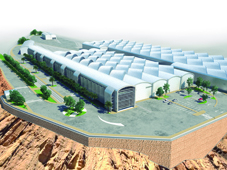
Idom is committed to three clear goals: reducing energy and water consumption, use of materials with low environmental impact and minimizing maintenance of the different buildings
Idom is responsible for the detailed design (construction) of the track and its associated components (viaducts, tunnels, false tunnels and platform at ground level), workshops and garages, park & rides ( and ride) parking, 20 stations and all the complex at street associated with the immediate passage of the Line 3 of the Metro Riad.
The commitment to energy efficiency and sustainability assessment is one of the of the building’s design highlights proposed by Idom with three clear objectives: Reducing energy and water consumption, use of low environmental impact materials and minimize maintenance.
The buildings of workshops and garages proposed by Idom are a case in point. Since the competition phase the workshops and garage buildings sought to create a functional and low energy demanding buildings through the architecture design. Riyadh’s weather conditions are extreme with a dry climate, a very high solar radiation and high temperatures that can reach 48°C. In the original design of Idom, the main strategy to reduce the energy consumption was based on bioclimatic concepts.
Due the roof’s design, the building is able to reduce direct solar incidence while allowing maximum daylighting levels. For this purpose a series of skylights were installed facing north, reducing the demand for cooling and artificial lighting simultaneously. The roof itself was defined by means of an optimization study of photovoltaic panels, which produced 45% of the consumption of fixed installations of the building.
The design is complemented with solar protection devices in façades, and a high reflectance with continuous high thermal insulation (U = 0.33W / m²K) envelopes to minimize heat gains. The active ventilation, thermal conditioning and lighting systems are robust and highly efficient. All water fixtures are highly efficient in order to reach a maximum potable water savings. The reuse of water is the other key strategy for assuring the water savings, gray water is recycled for cleaning and irrigation, and sewage is al reused for irrigation after the required treatment.
The stations are based on a predefined design, for which Idom is developing the project implementation. As in workshops and garages, the design focuses in reducing the energy needs of the stations, based on shading and high performance envelopes, along with the installation of solar PV panels that contribute to the reduction energy consumption of the stations.
